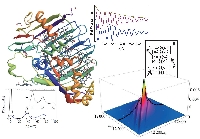
Institute of Theoretical Physics, Albert-Einstein-Allee 11, D-89069 Ulm, Germany
e-mail: felipe.caycedo@uni-ulm.de

 |
Felipe Caycedo-Soler, Alex W. Chin, Javier Almeida, Susana F. Huelga and Martin B. Plenio
Institute of Theoretical Physics, Albert-Einstein-Allee 11, D-89069 Ulm, Germany e-mail: felipe.caycedo@uni-ulm.de |
 |
Based entirely upon actual experimental observations on electron-phonon coupling, we develop a theoretical framework to show that the lowest energy band of the Fenna-Matthews-Olson (FMO) complex exhibits observable features due to the quantum nature of the vibrational manifolds present in its chromophores. The study of linear spectra provides us with the basis to understand the dynamical features arising from the vibronic structure in non-linear spectra in a progressive fashion, starting from a microscopic model to finally performing an inhomogenous average. We show that the discreteness of the vibronic structure can be witnessed by probing the diagonal peaks of the non-linear spectra by means of a relative phase shift in the waiting time resolved signal. Moreover, we demonstrate the photon-echo and non-rephasing paths are sensitive to different harmonics in the vibrational manifold when static disorder is taken into account. Supported by analytical and numerical calculations, we show that nondiagonal resonances in the 2D spectra in the waiting time, further capture the discreteness of vibrations through a modulation of the amplitude without any effect in the signal intrinsic frequency. This fact generates a signal that is highly sensitive to correlations in the static disorder of the excitonic energy albeit protected against dephasing due to inhomogeneities of the vibrational ensemble.